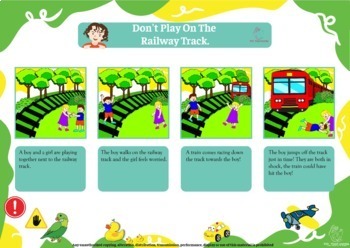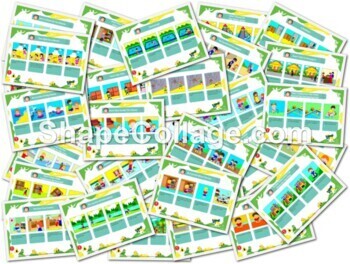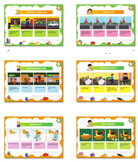SUPER BUNDLE: Dangerous situations, safety, safe, unsafe, sequencing stories,ABA
- Zip
Products in this Bundle (5)
Also included in
- Read, sequence, dangerous, safety, safe, autism, social skills, ABATEACHING YOUR KIDS ABOUT DIFFERENT DANGEROUS SITUATIONS USING OUR FANTASTIC WORKSHEETSBESTSELLER: Trust me! You don't find any material like this anywhere else. This is a MUST HAVE for every parent, teacher and their kids. This can sPrice $156.00Original Price $570.00Save $414.00
- BESTSELLER: 334 WONDERFUL SEQUENCING STORIES INCLUDED IN THIS SUPER BUNDLE:184 AMAZING STORIES ABOUT DAILY LIFEA broken vaseLost umbrellaBrushing your teethA good dogPet groomingMaking a sandwichBuilding a scooterA field mouseBreakfast surpriseAlphabetBalloon stuck in a treePlanting a treeCleaning yPrice $38.40Original Price $116.00Save $77.60
Description
BESTSELLER: Trust me! You don't find any material like this anywhere else. This is a MUST HAVE for every parent, teacher and their kids. This can save lives!
150 SEQUENCING STORIES WITH 150 DIFFERENT DANGEROUS SITUATIONS INCLUDED IN THIS SET. THE BOOK COVERS ALMOST ALL THE DANGEROUS SITUATIONS IN OUR DAILY LIFE:
- Don't Touch The Fan!
- Don’t Play On The Table
- Don’t Go Out Into The Cold Without Warm Clothes
- Don't Play In The Road
- Don't Climb Up Wire Towers
- Be Careful With Chopsticks
- Be Careful Of The Slippery Floor
- Don’t Climb On The Railing
- Keep A Safe Distance From Go-Karts
- Don't Play With Your Ball Inside The House
- Don’t Play With The Iron
- Don't Stay Under A Tree During A Storm
- Throw Your Banana Peel In The Trash
- Don't Play On The Escalator
- Always Wear Your Bicycle Helmet
- Don't Climb On Bridges!
- Be Careful With Q-tips
- Don't Push Your Friend On The Slide
- Watch Out For Bicycles
- Don’t Run In The Restaurant
- Don’t Get In The Washing Machine
- Don't Try To Get Into A Moving Vehicle
- Don't Ignore Warning Signs!
- Don’t Play With Ropes
- Don’t Touch Hot Things
- Don't Play With Perfume
- Be Careful Of Candles
- Be Careful Of Poisonous Plants
- Don't Ride Your Bicycle On A Stormy Day
- Don't Touch Electric Wires
- Be Careful Of Big Waves
- Be Careful With Knives
- Be Careful With Umbrellas
- Be Careful Of Wild Birds!
- Don't Talk To Strangers
- Be Careful It's Hot!
- Be Careful What You Eat
- Don't Try Silly Tricks On Your Bicycle!
- Don't Climb On Toy Blocks
- Don't Disturb Bees!
- Don't Eat Pills
- Don't Play With Firecrackers
- Don't Drink Any Liquids That You Don’t Know About
- Don't Get Close To The Cage
- Always Tidy Up Your Toys
- Don't Jump Into The Deep End Of The Swimming Pool
- Don't Go Too Close To The Lake
- Don’t Run Inside The House
- Drowning!
- Put Out Fires Safely
- A Robbery
- Don't Get Too Close To Wild Animals
- Be Careful With Glass
- Don't Run With A Sharp Pencil!
- Two Kids On A Beach
- Don't Open High Cupboards By Yourself
- Do Not Walk Down The Stairs For The Slide
- Don't Put Your Knife In Your Mouth!
- Be Careful Of Strangers
- Don't Stand On The Water Slide!
- Always Look Before You Cross The Street
- Be Careful When You Open The Car Door
- Always Wear A Seatbelt!
- Stay Away From No-Entry Areas
- Don't Accept Candy From Strangers
- Don't Wander Off By Yourself
- Don't Put Too Much Food In Your Mouth
- Always Ask For Help When Opening A Can.
- Be Careful With Sharp Knives!
- Be Careful Blowing Out Candles
- Be Careful, It Gets Hot Inside The Car
- Never Pull A Dog's Tail
- Don't Wander Off By Yourself
- Don't Touch Electric Plugs On The Wall.
- Don't Climb Trees Near Electric Wires
- Wash Your Hands After Using The Toilet
- Be Careful Of Hot Water
- Be Careful Of Strangers
- Don't Throw Rocks At Trains
- Never Eat Food That Flies Have Touched!
- Don't Play With The Ball In The Street
- Be Careful Not To Drop Things From Balconies
- Be Careful Of Steep Hills
- Don't Play With Water Inside
- Always Sit Carefully In A Boat
- Don't Hold Anything Out Of An Open Car Window
- Don't Disturb Wild Birds
- Don't Jump Too High On The Trampoline
- Don't Push
- Stay Away From Construction Sites!
- Don't Put Small Things In Your Nose
- Don't Play Near Deep Mud
- Don't Take Food Out Of A Dog’s Mouth
- Be Careful When Climbing
- Look Before You Close A Door
- Call An Adult If You Need Help
- Don't Play On The Railway Track.
- Don't Get Too Close To Fans
- Watch Out For Snakes
- Be Careful When Eating Small, Round Foods
- Don't Throw Things From The Balcony!
- Be Careful When Playing With Pellet Guns!
- Be Careful Of Hot Drinks
- It Hurts
- Find Somewhere Safe To Hide During An Earthquake
- Don't Put Your Head In Small Spaces
- Don't Stand At The End Of The Slide
- Don't Play With Chemicals
- Don't Play With Firelighters
- Be Careful Of Fish Bones
- Electric Shock!
- Don't Stand Too Close To A Fire
- Be Careful When Riding A Bicycle Down The Hill.
- Don't Play Next To A Lake
- Don't Go Inside Garages
- Don't Run On The Stairs
- Don't Touch Things In The Shop
- Don't Play With Yarn
- Don’t Climb On The Slide
- Be Careful When Walking Near A Lake
- Be Careful Of Hot Water
- Don't Use Electric Devices Near Water
- Don't Touch Broken Glass!
- Don't Drink Adult Drinks
- Don't Jump Off Bridges
- Don’t Play On The Banister
- Be Careful With Knitting Needles
- Always Hold On Tight On A Motorbike
- Don't Ride Your Bicycle Without Holding On!
- Be Careful Of Sharp Toys
- Be Careful Using Forks
- Don't Play On The Stairs!
- Be Careful With Toy Swords
- Don't Climb Out Of The Window
- Don't Climb Up The Slide
- Don't Move A Glass Mirror
- Be Careful Of Boiling Water
- Don't Play With The Stove
- Watch Out For Broken Glass
- Slippery Ice
- Don't Cut Electric Wires
- Don't Climb On The Escalator
- Don't Play Outside In The Sun For Too Long
- Don't Climb And Jump Off Things In The House
- Don’t Play With Knives
- Don’t Lean Out Of A Car Window
- Be Careful Playing With Pillows
- Don't Throw Rocks At Cars
- Don't Play With Electric Wires!
- Don't Play With Plastic Bags!
Dangerous situations, safety, safe, unsafe, scenarios, Life skills, Social situations, Personal safety, Danger, autism, ADHD, Special needs, ABA
TEACHING CHILDREN ABOUT DANGEROUS SITUATIONS
Teaching children to avoid strangers is not enough. We must also teach them to recognize and respond to potentially dangerous situations. We can protect our kids from dangerous situations by teaching them, and by taking a few precautions of their own.
This set belongs to my very big ‘’Dangerous situations’’ package which I have spent almost 5 years creating. They are the most fantastic teaching materials you can find to teach kids about dangerous situations. This has helped SO MANY children, and A LOT of them are kids with special needs (autism, ADHD…).
Trust me, this can save lives!
My package covers almost EVERY SINGLE DANGEROUS SITUATION in our daily life: pools, rivers, lakes, fire, poison, guns, child enticement, bullying, and MANY more...
To Keep Kids Safe, Explain, Explain, Explain! It is important to teach kids about dangerous situations BEFORE they happen!
WHY SEQUENCING STORIES?
- Do you know a child who is not able to set the table? The child struggles with what should
be done first and where everything goes.
- Do you know a child who can’t follow the specific “order” of steps to solve math problems correctly?
- Do you know a child who struggles to tell you about their school day? When they try to tell you about it, their story may be jumbled and hard to follow?
If yes, then these kids may have trouble with sequencing. Sequencing is such an important tool to learn for our students because it affects their ability to tell a story, comprehend a book, retell a story they read, order events to make a plan, or tell you about something they did. That is why sequencing has a huge impact on literacy, language, communication, and social interaction. It is a must-teach skill in a developmental curriculum.
Language is the very first thing kids learn to sequence. They know that when they use words and sounds in a particular order, they get certain results. Language issues aren’t the only reason for trouble with sequencing tasks. Working memory issues cause some children to lose hold of the proper order of doing things.
Teaching sequencing is considered one of the most important things in speech therapy. It is a critical communication and life skill. Sequencing is the process of combining things in a particular order – the following of one thing after another. In the context of speech and language, sequencing refers to a skill that we use to discover the components of an event and break it down into simple steps, such as the beginning, the middle and the end of an event. It also refers to the ability to align thoughts, language, knowledge, information or actions in a certain order and retrieve them to complete a given task.
We use sequencing skills in all areas of our life and don’t even realize it. You use these skills to follow multi-step directions, complete a math problem, break a big task into small tasks, form complete sentences with the correct syntax, or to retell a story.
Our sequencing stories are teacher-approved for language and speech therapy students. Each story contains four pictures with simple sentence descriptions. These will strengthen our children’s sequential auditory skills as well as logical thought and visual memory process. Our children will improve their communication skills as they retell each story in their own words.
Sequencing skills are an important part of language development. The ability to sequence is one of many skills that contributes to students' ability to comprehend what they read. Sequencing is a foundational skill to many aspects of language, executive functioning skills, and other areas of academics. Sequencing is a common area that children struggle with. If they don’t develop a strong foundation when they are young, it’s easy to get behind and it can affect many areas of their lives. Sequencing difficulties can be a result of language deficits, executive functioning issues, or lack of attention skills.
Sequencing is the ability to arrange language, thoughts, information and actions in a certain order to get things done. Without this skill, it’s hard to complete tasks correctly. And it’s often the reason why some kids seem unable to follow simple directions.
It is very likely that trouble with sequencing language will cause problems for the child down the line. Without those early skills, kids have a harder time developing a natural sense of how other things should be ordered. Younger children who have trouble with sequencing often struggle with sequences of pretend play. They might also say sentences in a muddled order or say things that seem unrelated to the topic.
Older or more verbal children who struggle with sequencing often find it hard to tell a story or a piece of news; as they jump backwards and forwards and miss important parts out. They might not be able to answer the question they were asked or may waffle and fail to come to the point.
Sequencing is also an important reading comprehension strategy. It allows students to make sense of how events unfold in their reading. In turn, these reading skills will help students in their own writing. It will help them to construct a cohesive and logical flow to their writing that readers can easily follow.
Strong sequencing skills help students:
○ With their reading comprehension of a text, especially narrative texts.
○ Understand the structure of a text and how it is put together.
○ Understand how texts are kept cohesive through the use of linking devices such as connectives and transitions.
○ Organize information and ideas in their own writing.
○ Develop problem-solving skills that are important in other curriculum areas too.
This resource has been teacher-tested and approved, works great for large or small groups, at learning centers, as a content assessment tool. This is also excellent for kids with autism, ADHD or other special needs.
Once you have purchased this resource don't forget to come back and leave feedback to help you gain some TpT credits! The credits build up and then you can use them off future purchases - from any seller on TpT!
If you want to keep up to date with my sales, new resources, freebies and so much more click the green ★ next to my store name!
© 2020 KIDS’ VISUAL LEARNING, QUYNH CHOLEVA - ALL RIGHTS RESERVED
Any unauthorized copying, alteration, distribution, transmission, performance,
display or other use of this material is prohibited.
Recognizing and Handling Dangerous Situations
How to teach your children to handle dangerous scenarios?
Young children's concepts of danger
Teach your children about staying safe in a dangerous situation
dangerous situations at school
dangerous situations in everyday life
identifying dangerous situations
safe and unsafe scenarios
safe and unsafe scenarios free
dangerous situation scenarios
safe vs. unsafe situations
safe and unsafe situations worksheet







